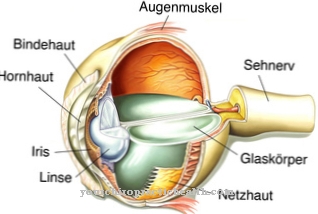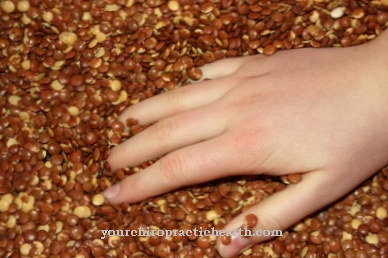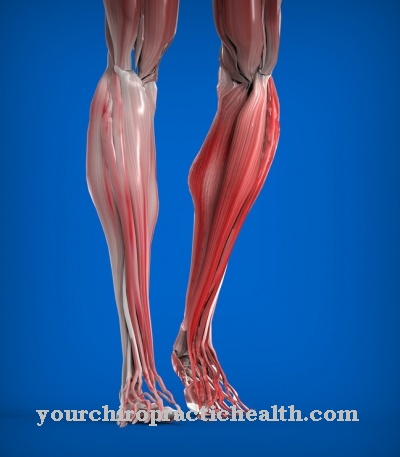Atchoo! Everyone knows it: a sudden expulsion of air. But what happens when Sneeze actually? Sneezing is an involuntary and explosive expulsion of air through the nose - often also through the mouth.
What is the sneeze?

Sneezing is the expulsion of air through the nose and mouth. It is triggered by an urge to sneeze. Sneezing is intended to throw nasal secretions as well as dust or other foreign bodies - for example pepper as a sneeze stimulus - out of the nose.
There are many possible causes for sneezing: irritation of the nasal mucosa is just as possible as very bright light, an allergy or sexual arousal.
Sick people in particular should try not to sneeze around other people, because when sneezing, bacteria and pathogens can be transmitted through droplet infection.
Sneezing itself has three phases. Air is inhaled first. Then, after briefly holding the breath, the exhalation muscles of the stomach and chest suddenly contract. At this moment, the air is expelled through the nose and mouth again - and at an amazing speed: sneezing speeds of over 160 to 180 km / h have been measured.
Function & task
Sneezing is first and foremost a protective reflex of one's own body, with which various foreign objects are removed from the nose. No matter what foreign body it is: dust, bacteria, viruses, pollen, insects or microorganisms. Your own nasal secretions can also be responsible for a sneeze. Anything that irritates the nasal mucous membrane in any way can trigger a sneeze reflex.
Typically, people sneeze mostly in autumn and winter, and sneezing often serves as an advance warning for a classic cold. However, you don't have to be or get sick to sneeze.
Another classic example of a sneeze reflex is allergies. For example, pollen or animal hair irritate the mucous membrane and an inflammatory reaction occurs. The subsequent sneeze throws all foreign bodies out and frees the airways.
However, some people also have to sneeze, for example when they pluck their eyebrows. This is due to the so-called trigeminal nerve (trigeminal nerve). It is the fifth cranial nerve and plays a key role in sneezing. It is widely ramified and for example also transmits stimuli and pain to the brain. Plucking hair, in this case eyebrows, can irritate this nerve so that you have to sneeze even though there is no stimulus on the nasal mucosa - the nerve is practically deceived.
Sneezing is therefore a self-cleaning function of the body, and it is also harmless for healthy people. Sneezing should also not be suppressed: the pressure creates the risk of damaging the middle ear or eardrum. In addition, suppressing bacteria can also get into the sinuses. Painful inflammation can result from suppressed sneezing.
You can find your medication here
➔ Medicines for colds and nasal congestionIllnesses & ailments
There are a surprising number of horror stories about the phenomenon of sneezing. One rumor that persists in people's minds is that while sneezing, it is said that bodily functions stop. It is also just a myth that your eyes will pop out if you don't close them while sneezing.
Sneezing can actually upset the heart and circulation for a brief moment, but the pulse and blood pressure usually return to normal immediately after the sneeze. In rare cases, sneezing can also lead to fainting - a doctor should be consulted in any case.
What is certain, however, is that sneezing can transmit bacteria and other pathogens via the droplet infection. Because in addition to coughing, sneezing is one of the main sources of infection with colds or flu-like infections. It is not for nothing that after a sneeze one wishes the person concerned "health".
Treatment for sneezing depends on what causes it: an allergy or a cold. With a cold, sneezing is just a symptom that occurs along with other symptoms such as a cough, runny nose, or sore throat. In this case, the whole cold needs to be treated.
If the sneeze is allergy-related, for example hay fever or pollen allergy, the person concerned must either avoid the allergen or take an antihistamine so that the sneezing subsides. In the case of severe allergies, desensitization can also be carried out. During this treatment, the patient receives minimal doses of his allergenic substance injected under the skin at regular intervals. After completion of the treatment, the body no longer reacts to it or reacts less with allergic editors - such as sneezing.
The sneezing reflex can, however, also be outwitted if it really has to be. For example, it helps if you press your tongue firmly on the roof of your mouth. Another option is to place two fingers on the bridge of the nose and gently squeeze them. However, both methods only work if you react to the first warning signal, the tingling sensation in your nose. This can easily suppress sneezing.













.jpg)

.jpg)
.jpg)











.jpg)